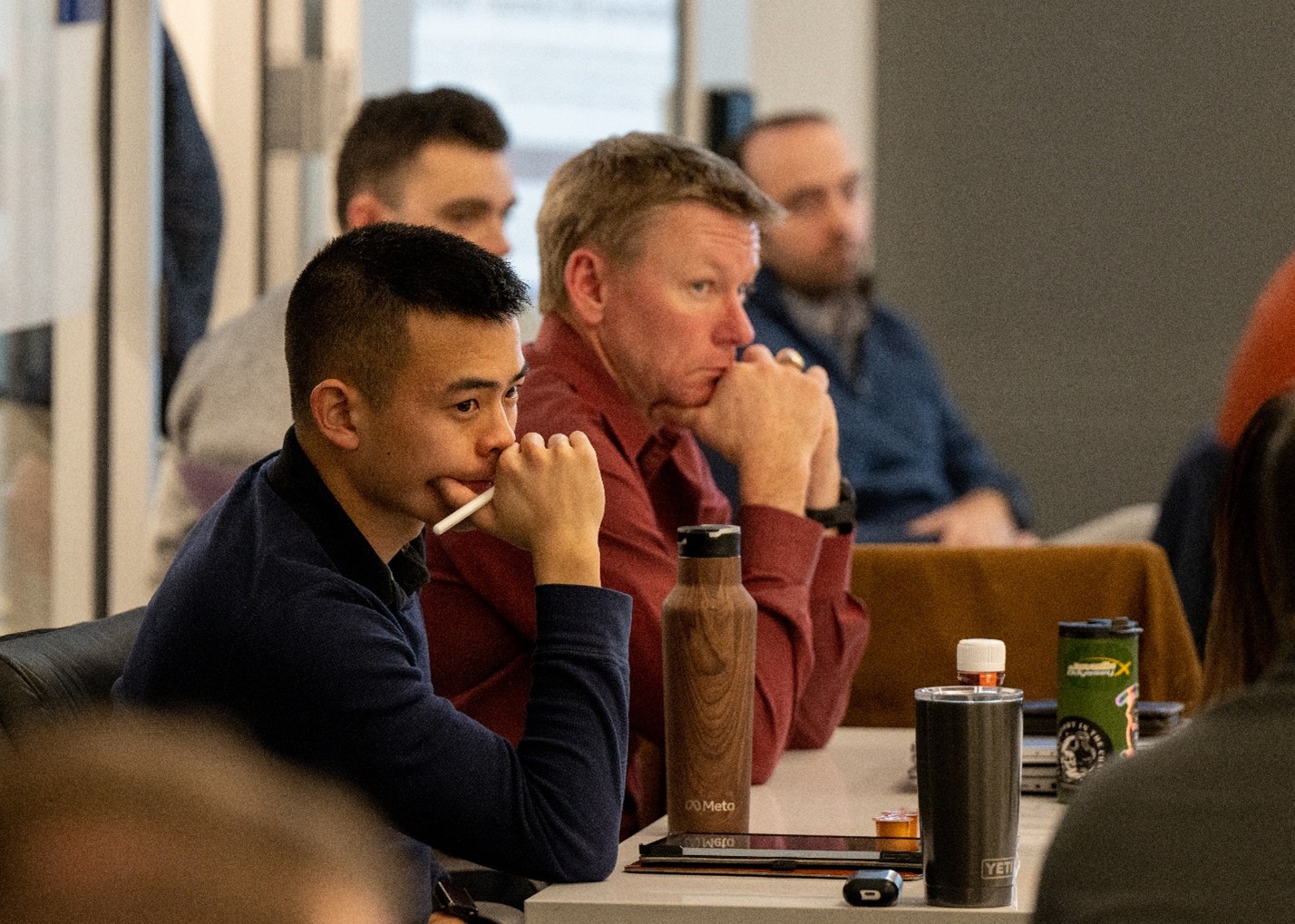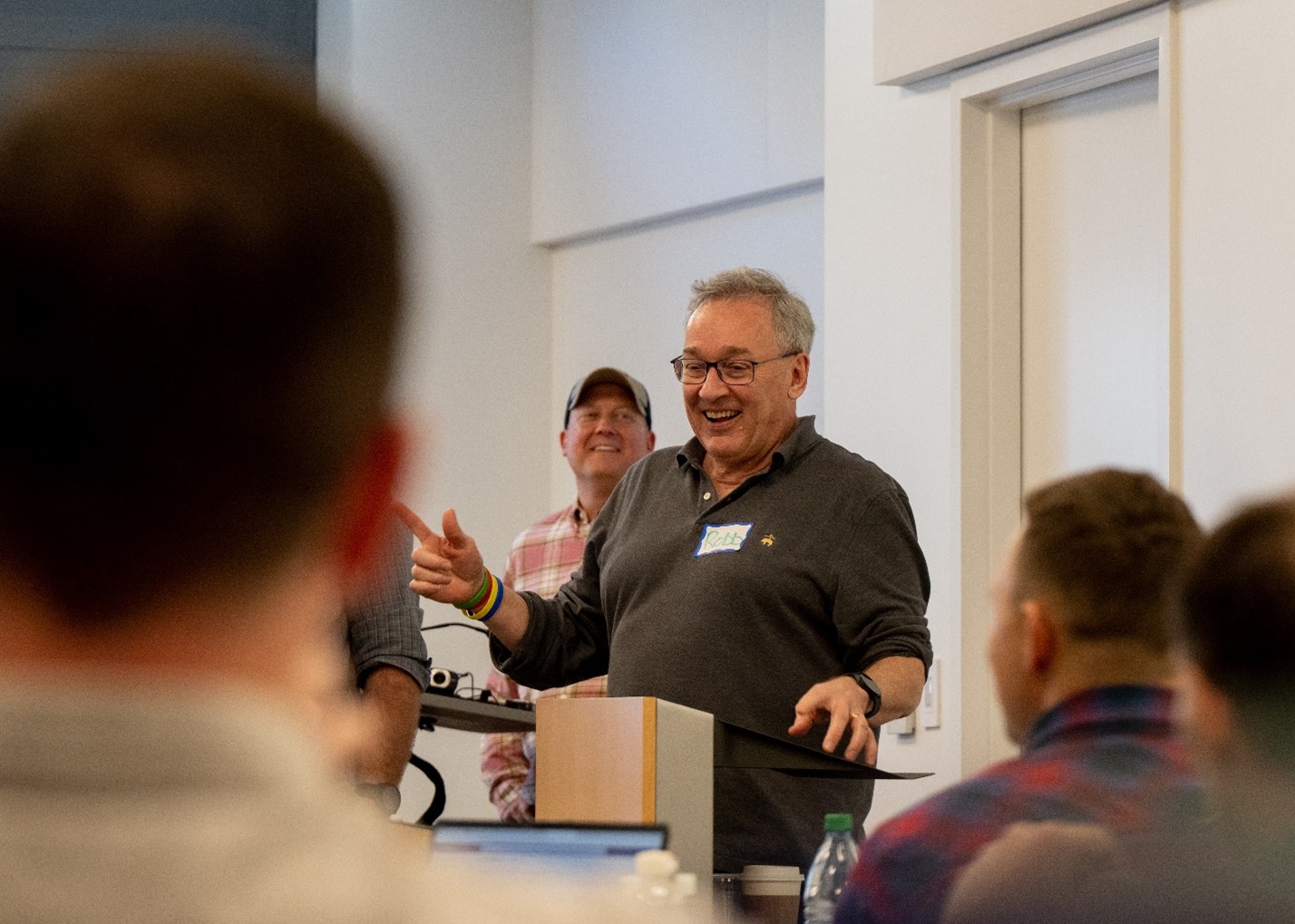“Aiming High” to Innovate With the Department of Defense
By Capt. Kippun Sumner
Duke partners with the Michigan Air National Guard and the U.S. Air Force to accelerate innovation in the Department of Defense

Military leaders, academic experts and industry partners from around the country recently gathered at Duke University to identify and attempt to solve some of the Department of Defense’s highest-level strategic challenges. Their mission, should they choose to accept it; to “Accelerate, Change or Lose.”
That is the action order that the U.S. Air Force’s Chief of Staff, General Charles Q. Brown Jr., challenged his service with when he assumed command in 2020. It’s also the driving mindset behind the Academia-Industry-Military Hybrid Innovation (AIM-HI) program—a 10-week intensive course in innovation that is part of a new partnership between Duke and the Air National Guard.
“We are certifying service members to be innovators,” said Michigan Air National Guard Lt. Col. David Brewer, AIM-HI Program Director. “We’re training them to pursue rapid, disruptive innovation to transform the military and echo Gen. Brown’s challenge to modernize the force.”
“We are certifying service members to be innovators. We’re training them to pursue rapid, disruptive innovation to transform the military and echo Gen. Brown’s challenge to modernize the force.”
Lt. col. david brewer, Michigan Air National Guard, AIM-HI Program Director
In a rapidly changing global landscape with dynamic new challenges, the Air Force and DoD at large are looking to build a culture of innovation. A key priority of that effort is forming new and innovative military partnerships with academic and industrial partners.
“AIM-HI is partnering with Duke University and the National Security Innovation Network to bolster new and emerging capabilities for leading national security initiatives,” Lt Col Brewer said.
The AIM-HI Program, officially certified through the University of Michigan and the Kelly Johnson Joint All-domain Innovation Center, seeks not only to create new ideas, but to instill a lasting culture of innovative thinking in the U.S. military.
 “It’s an outstanding collaboration, these participants are coming from the Air National Guard, the Air Force, the U.S. Army, special operations communities and even a Duke Air Force ROTC Cadet,” Lt Col Brewer said. “It’s the full spectrum of ranks and career fields and operational experience.”
“It’s an outstanding collaboration, these participants are coming from the Air National Guard, the Air Force, the U.S. Army, special operations communities and even a Duke Air Force ROTC Cadet,” Lt Col Brewer said. “It’s the full spectrum of ranks and career fields and operational experience.”
During the kick-off week held in-residence at Duke, the 25 AIM-HI students broke out into five-member teams and tackled a high-level DoD challenge such as space resiliency, agile combat employment, combat medical responses and more. Guided by veteran participants and innovation coaches, project participants rapidly formed team dynamics and built out the first steps of translating abstract challenges into actionable problem statements and solutions.
The connection between Duke and the DoD is Professor Robb Olsen, an assistant professor at the Duke Pratt School of Engineering, and his wife Kate Olsen, a Duke Engineering Alumni. They work in tandem as the AIM-HI Program Curriculum Lead Instructors.
“After a career of innovation in industry, it is a joy to be back on Duke’s campus teaching qualitative research methods and innovation to our military,” said Kate Olsen, who received her Bachelor of Science in Engineering from Duke in 1986.
“This sort of partnership furthers a strategic imperative we have at Pratt, to strengthen our collaborations with industry and the military. Duke is a landmark location for research and education, and we want it to be that for innovation as well.”
kate olsen, P’86
“This sort of partnership furthers a strategic imperative we have at Pratt, to strengthen our collaborations with industry and the military,” Olsen said. “Duke is a landmark location for research and education, and we want it to be that for innovation as well.”
“Both the armed forces and Duke have strong traditions and cultures that will be on full display this week as we pursue what we hope will become the first collaboration of a long-term partnership with AIM-HI,” said Jerome Lynch, the Vinik Dean of the Pratt School of Engineering. “Serving our country through the armed forces is one of the noblest callings one can follow, and the opportunity to host this program is our way to honor this service and everything the military does to ensure the security and prosperity of our country and our communities.”
 After the initial week at Duke, participants will continue to hone their ideas and innovation pitches at locations across the country, partnering with additional military programs (such as U.S. Special Operations Command), and industry partners before ending with a pitch to senior leaders in Washington, D.C.
After the initial week at Duke, participants will continue to hone their ideas and innovation pitches at locations across the country, partnering with additional military programs (such as U.S. Special Operations Command), and industry partners before ending with a pitch to senior leaders in Washington, D.C.
What makes this program special is that it is more than just a study in innovation, but a real-world opportunity for teams to have their ideas implemented in the Department of Defense.
“For me as an educator, it’s more than just theory; I am interested in giving people skills that work and scale out in the world. That’s our big priority with AIM-HI. It’s not just an academic program. We learn innovation by doing,” said Olsen. “Last round, we had five out of our eight participating teams receive actual funding to solve big strategic challenges of importance to the Air Force Chief of Staff and other senior military leaders.”
“Serving our country through the armed forces is one of the noblest callings one can follow, and the opportunity to host this program is our way to honor this service and everything the military does to ensure the security and prosperity of our country and our communities.”
Jerome Lynch, Vinik Dean of the Pratt School of Engineering
“We are a professional development program, we are trying to take the talent that comes from within Duke, and roll it into AIM-HI to better the output for the DoD,” Lt. Col. Brewer said. “We’re trying to build a replicable process for these service members to take back to their units.”
Students that complete the course will receive a certificate in professional innovation from the University of Michigan, and U.S. Air Force members can apply for and receive a special experience identifier, authorizing them to formally educate their home units about the practices learned in the program.
“We’ve taken the best of how academia teaches innovation and how the military executes it, and we’ve melded that into something unique, more advanced and more effective than any one method of innovation,” Olsen said. “This program is the equivalent of about two-and-a-half graduate semesters condensed into 10 weeks. It’s intensive and highly selective. This sort of sponsorship between the Michigan Air National Guard and a program like AIM-HI is how we win.”
With a focus on generating the adoption of new ideas and processes and a hybrid blend of theory study and real-world implementation, the AIM-HI program has a promising future. Not just to train future leaders, but to build a lasting community of practice for both the defense industry and academic communities alike.
“Innovation is a useful new thing adopted by a human group,” says Olsen. “If it’s only useful and new, it’s just an invention. But when you add ‘adopting by a human group’ as a requirement…that’s where you change the world.”
